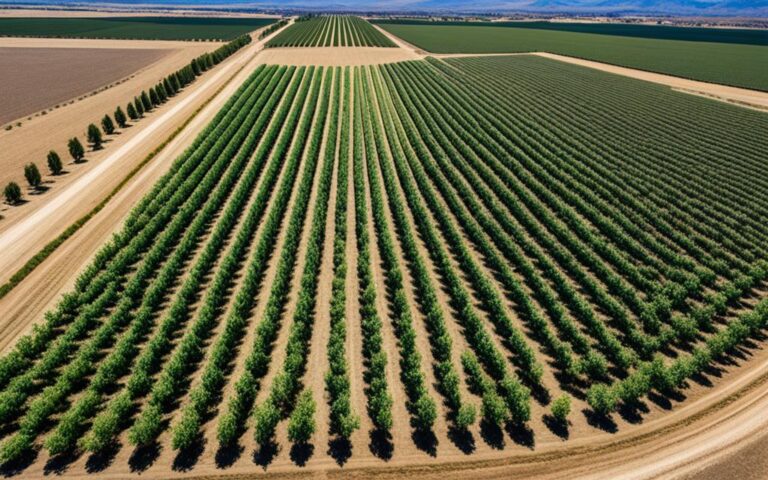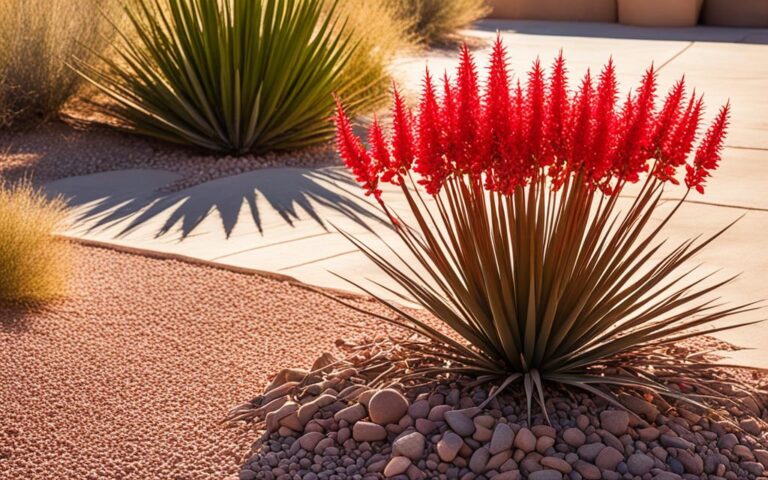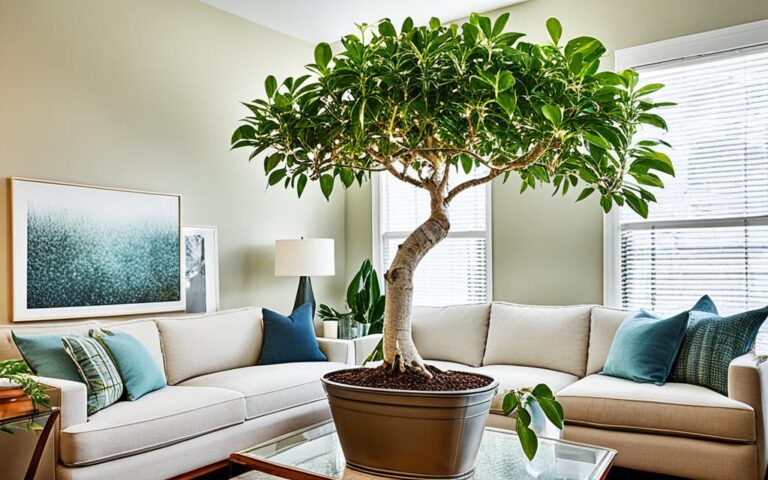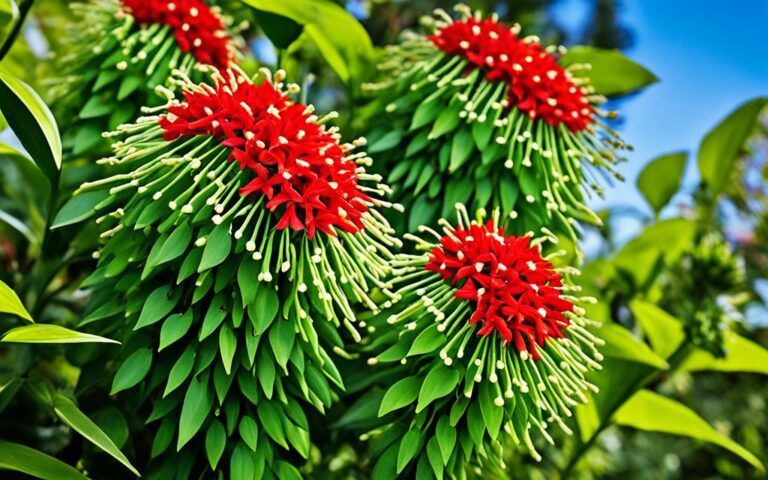Exploring Prickly Plant Parts: Nature’s Defenses
Plants have developed amazing ways to protect themselves from threats. One of the most interesting is the use of prickly parts. In fact, a plant loses about 99% of its water through its leaves. This makes leaves a key area for protection.
From the stinging nettles that inject chemicals to the poison ivy that causes allergic reactions, plants have many prickly features. These features show how plants have found smart ways to keep predators away, save water, and survive in their habitats.
Key Takeaways
- Prickly parts are key for plants to defend against herbivores and environmental stress.
- Plants have different prickly structures like thorns, spines, and prickles, each with its own role.
- Prickly plants are important for animals, offering shelter and food.
- Cacti, thistles, and hawthorns are famous prickly plants with unique adaptations.
- Prickly parts of plants can also be useful, like in making certain vegetables and fruits.
Introduction to Prickly Plant Parts
Prickly plants are known for their thorny or spiny features. These can vary a lot among different plants. They usually protect the plant from being eaten by animals. Learning about these plants helps us understand how they have changed over time and their role in nature.
Defining Thorns, Spines, and Prickles
Thorns are sharp, pointed parts that come from stems or branches. Spines are hard, sharp parts that come from leaves or parts of leaves. Prickles are growths from the plant’s skin, not from stems or leaves.
Significance of Plant Defenses
These prickly parts are key to how plants defend against animals and survive tough places. Prickly pear is easy to care for and loves the sun and little water. It’s perfect for dry areas. Its stems, or pads, can be 4 to 18 inches long and have smooth skin or spines.
Prickly pear uses a special way to make food called CAM to save water. This lets it live in hot, dry places. It can quickly soak up water and dry out when it rains, helping it survive in dry lands.
| Prickly Plant Feature | Description |
|---|---|
| Thorns | Modified stems or branches that have evolved to become sharp, pointed structures. |
| Spines | Modified leaves or parts of leaves that have hardened and sharpened. |
| Prickles | Outgrowths from the plant’s skin or epidermis, not modified stems or leaves. |
These prickly parts help protect the plants from being eaten. They let the plants live in tough places and do well in sunny, dry areas like Texas.
Thorns: Hardened Stem Structures
Thorns are a special feature in the plant world. They are sharp and pointy, acting as a strong defense. They help keep away animals that might eat the plant’s flowers and leaves. Unlike prickles, thorns have vascular tissue, which is important for the plant.
Examples of Plants with Thorns
Rose bushes are a great example of plants with thorns. Their sharp stems and branches keep away threats. Other plants like the Washington hawthorn, honey locust, and black locust also have thorns. These thorns help protect their resources and ensure they can keep growing.
Some people call thorns and prickles the same thing, but they’re not the same. Prickles are just plant outgrowths without vascular tissue. True thorns have vascular tissue, which is different.
The development of thorns shows how plants adapt to protect themselves. These hard parts act as a strong shield. They help the plant survive by keeping away animals that might eat them.
Spines: Modified Leaves for Protection
Spines are a key defense in many plants against herbivores and predators. They are different from thorns, which come from stems or branches. Spines come from leaves or leaf parts that have turned hard and sharp over time.
Cacti and succulents are famous for their spines. These spines are vital for their survival in dry places. They keep away herbivores and also cut down on water loss by covering less surface area from the sun and wind.
Some plants like holly and Oregon grape holly have spiny edges on their leaves. These spines grow from the main veins of the leaves, adding more protection. Plants like Agave and Yucca have sharp spines at the leaf ends.
| Plant | Spine Type | Spine Characteristics |
|---|---|---|
| Cacti | Spines derived from leaves | Crucial for survival in arid environments, help reduce water loss |
| Holly, False Holly, Oregon Grape Holly | Spiny appendages on leaf edges | Extensions of leaf’s major veins, provide additional protection |
| Agave, Sansevieria, Yucca | Terminal spines at leaf ends | Sharp points that deter herbivores |
Plants show amazing adaptations with their spines to protect themselves and survive. These spines help them face threats and thrive in their environments.
Prickles: Epidermal Outgrowths
Prickles are special parts of plants that are different from thorns and spines. They grow from the plant’s skin or epidermis, not from stems or leaves. These outgrowths can be found in many plants, each with its own way to defend itself.
Plants with Prominent Prickles
The rose bush (Rosa spp.) is famous for its prickles. These hair-like prickles cover the stems and keep animals away. The greenbrier (Smilax spp.) is another plant with prickles. Its climbing stems make it hard for animals to get through.
The horsenettle (Solanum carolinense) has prickles on its stems and leaves. This makes it hard for predators to eat it. Spiny amaranth (Amaranthus spinosus) and the mile-a-minute vine (Persicaria perfoliata) also have stiff prickles. These prickles keep small animals from climbing or getting close to the plants.
| Plant | Prickle Description |
|---|---|
| Rose Bush (Rosa spp.) | Numerous, hair-like prickles on stems |
| Greenbrier (Smilax spp.) | Prickles along climbing stems |
| Horsenettle (Solanum carolinense) | Prickles on both stems and leaves |
| Spiny Amaranth (Amaranthus spinosus) | Stiff, prominent prickles |
| Mile-a-Minute Vine (Persicaria perfoliata) | Stiff, discouraging prickles |
“Prickles are woody outgrowths from a plant’s skin or bark and can be numerous, similar to hair, they are derived from the epidermis.”
Adaptations of Prickly Plant Parts
Prickly parts like thorns, spines, and prickles have evolved to protect plants from herbivores. They also help plants survive in tough places, especially deserts.
Deterring Herbivores
These adaptations keep herbivores away by causing harm or discomfort. For example, citrus trees use thorns to protect themselves. Apple, plum, and pear trees also have thorns but some modern types don’t.
Reducing Water Loss
In dry places, spines help by shading the plant and cutting down on air flow. This reduces water loss. Spines also protect the plant’s water storage from damage.
Xeric plants like cacti have turned their leaves into spines. This cuts down on water loss. Spines also block sunlight and wind, giving the plant shade. They help collect water vapor at night in dry areas.
| Prickly Plant Adaptation | Purpose |
|---|---|
| Thorns | Deter herbivores, protect stems and branches |
| Spines | Reduce water loss, provide shade, collect condensation |
| Prickles | Deter herbivores, protect plant surfaces |
“Prickly plant parts have developed various adaptive strategies that not only protect them from predators but also help them thrive in challenging environments.”
Ecological Roles of Prickly Plants
Prickly plants are key to keeping ecosystems balanced. They offer shelter and homes for many animals. These plants, with their thorns and spines, are safe spots for different species. This helps keep the variety of life in nature high.
Providing Shelter and Habitats
Cacti and thistles are great shelters for many animals. Cacti have complex shapes that make perfect homes for birds, insects, and small animals. Thistles, with their thick spines, protect small mammals and birds, making them key parts of the ecosystem.
These plants do more than just provide shelter. They also feed many animals. Their flowers, fruits, and leaves are food for pollinators, herbivores, and animals that spread seeds. This shows how important prickly plants are for the health of their ecosystems.
Prickly plants also make ecosystems more diverse by creating special spots and climates. This diversity helps ecosystems stay strong and flexible, making them better at handling changes and challenges.
“Prickly plants are the unsung heroes of the natural world, providing vital shelter and sustenance for a wide array of species, thereby maintaining the delicate balance of their ecosystems.”
The Saguaro Cactus: A Prickly Icon
The saguaro cactus towers over the American Southwest desert. It can grow over 12 meters tall and live more than 150 years. This plant has evolved to survive in the desert.
It has a thick, waxy coating to save water. Its spines protect it from animals, helping it save water. The tallest saguaro was 78 feet tall before it fell in 1986.
The saguaro cactus is more than tough. It’s crucial to the desert ecosystem. Its white flowers bloom in June and feed pollinators. The fruits in June feed animals like the Gila woodpecker and the lesser long-nosed bat.
The saguaro cactus is listed as “Least Concern” by the IUCN. It thrives in the Sonoran Desert, showing how it has adapted to harsh conditions.
| Statistic | Value |
|---|---|
| Conservation status | Least Concern |
| Maximum height | 78 feet (23.8 meters) |
| Lifespan | Over 150 years |
| Growth rate | 20-50 years to reach 1 meter (3 feet 3 inches) |
| Root system | Up to 30 meters (100 feet) wide, 1 meter (3 feet 3 inches) deep |
| Flower stamens | Up to 3,482 per flower |
| Fruit seeds | Around 2,000 per fruit |
The saguaro cactus is a symbol of the American Southwest. Its size, long life, and role in nature make it a prickly icon. It shows how plants can survive in harsh deserts.
Hawthorns: Thorny Protectors
Hawthorns are small trees or shrubs with dense thorns on their branches. They grow in temperate regions and are known for their spring blossoms and berries. But their thorns do more than just look pretty. They protect the plant from hungry animals.
There are over 380 species of hawthorns, each suited to its environment. The common hawthorn can grow up to 6 meters tall, while the fireberry hawthorn is much smaller, reaching only 6-18 feet. These plants have long, sharp thorns that keep animals away from their leaves, flowers, and fruits.
Hawthorns are not just tough on the outside. They also provide shelter and nesting sites for birds and small wildlife. This makes them key to their ecosystems. The flowers draw in pollinators, and the berries feed birds and other animals.
“Hawthorns are the ultimate plant defense, creating a thorny fortress that safeguards their tender parts while offering refuge to countless creatures in need of protection.”
Hawthorns can be tall or form dense hedgerows. They act as guardians, protecting their territory with their sharp thorns. This shows how nature has come up with clever ways for survival.
Thistles: Spiny Survivors
Thistles are herbaceous plants known for their spiny leaves and stems. They live in many places, from meadows to areas disturbed by humans. Their sharp defenses keep away hungry animals and help them get resources.
Importance for Pollinators
Thistles might look tough with their spines, but they’re key to ecosystems. They feed many pollinators like bees and butterflies. The flowers give them nectar, which is important for their survival.
Thistles also help birds like goldfinches by offering seeds to eat. This shows how thistles keep nature in balance.
| Thistle Fact | Statistic |
|---|---|
| Canada thistle height | 0.3–1.5 m (1–5 ft) |
| Canada thistle seed viability in soil | Up to 20 years |
| Estimated economic impact of Canada thistle | $XX on crop and rangeland |
| Bull thistle seed production | Hundreds of flowers, each releasing hundreds of seeds that remain viable for over 10 years |
Some people see thistles as a problem because they spread and are prickly. But, they’re crucial for many species. They offer food and shelter, making them vital to nature.
prickly plant part: Nature’s Ingenious Defenses
Prickly plant parts show how nature protects its plants. Thorns, spines, and prickles do more than just defend. They help plants survive in tough places and support many species.
Learning about prickly plant parts helps us see their value. These features have evolved over millions of years. They show how plants can adapt and survive.
Thorns are hard parts of stems that keep animals away from the plant. Spines are like modified leaves that also protect the plant. Prickles are small outgrowths that cover the plant, making it hard for predators to get close.
Where prickly parts are placed and how many there are matters a lot. They help plants save water and nutrients by keeping animals away. This also helps other animals by providing homes and shelter.
Prickly plants are not just a problem to avoid. They show how evolution has shaped our world. Knowing their importance helps us care for these amazing plants.
“The thorns and spines of plants are not merely passive defenses, but active participants in the grand drama of life, shaping the very contours of the natural world around them.”
Chemical Defenses of Prickly Plants
Prickly plants use more than just thorns and spines to protect themselves. They have a strong chemical defense too. This chemical arsenal works with their physical barriers to keep herbivores away.
Saponins in some cacti spines are a great example. These toxic compounds can hurt animals if they eat them. This adds to the cactus’s defense, making it harder for predators to attack.
Other prickly plants have their own chemical defenses. For instance, nettles and dieffenbachia have cells that release venom-like enzymes. These can cause serious harm or even death to some animals.
The Mimosa pudica plant closes its leaves when touched, making it less likely to be eaten. Many plants also release chemicals when they feel stressed. These chemicals can make them even more toxic to pests.
| Plant Species | Chemical Defenses | Effects on Herbivores |
|---|---|---|
| Cacti | Saponins | Toxic if ingested |
| Nettles, Dieffenbachia | Idioblasts (specialized defensive cells) | Potential nerve damage or fatality |
| Mimosa pudica | Crypsis (leaf closing mechanism) | Reduced predation |
| Various plants | Volatile organic compounds (VOCs) | Increased production of toxic compounds |
The development of chemical defenses in prickly plants shows nature’s cleverness. These toxic compounds and deterrents work with the plants’ physical traits. Together, they form a strong defense against herbivores.
Seed Dispersal Mechanisms
Prickly plants have come up with smart ways to spread their seeds far and wide. They use burrs, those annoying, sticky parts that stick to animals. These burrs help the seeds travel to new places where they can grow well.
This method of seed spreading, called epizoochory, is a key way for prickly plants to grow their family. When animals move around, the burrs stick to them. Then, the seeds fall off in new spots, helping the plants move into new areas.
Research shows that animals helping to spread seeds has happened over 100 times in flowering plants. Also, fruits like raspberries and cherries get moved around by animals eating them. This is called endozoochory.
Prickly plants are experts at spreading their seeds. They use burrs and other tricks to make sure their seeds keep their family going. This helps them live in many different places.
The ways prickly plants spread their seeds show how smart nature is. From sticky burrs on animals to tasty fruits for animals, these plants have found great ways to spread out. This lets them grow and cover the world.
Prickly Vegetables and Fruits
Prickly plants aren’t just about thorns and spines. Some common veggies and fruits have their own prickly sides. For example, some eggplants have small spikes on their stems and calyx. Yellow squash plants have sharp stems and leaves. And, some cucumbers have spiny fruits and stems.
The artichoke is another prickly plant you can eat. It has prickly leaves and thistle-like flowers. These plants use their spines and prickles to protect themselves from animals.
Some prickly plants are now easier to use because of breeding. For instance, many nopal (prickly pear) pads are spineless now. This makes them simpler to use in cooking. Yet, they still have lots of vitamins, minerals, and antioxidants.
Prickly veggies and fruits add something special to our meals. They show how plants adapt to protect themselves. By learning about these plants, we can enjoy their unique flavors and health benefits.
Prickly pear is a superfood because of its nutrition. It’s full of vitamin C, calcium, antioxidants, and more. The pads are also packed with iron, vitamin A, and other nutrients. They’re mostly water, making them great for animals and people too.
Enjoying a grilled nopal pad or a ripe prickly pear fruit is a treat. These plants offer a special and healthy addition to our meals. By using their natural defenses, we get to enjoy their health perks.
Managing Prickly Weeds
Many prickly plants love to grow where they shouldn’t, like by roads, construction sites, or in gardens. It’s important to spot and control these prickly weeds because they spread fast. They can move by wind, water, animals, birds, or even people and pets. Pulling them out when they’re young stops them from spreading more.
Using herbicides is a good way to fight prickly weeds. Studies show that certain herbicides can kill up to 100 percent of these plants. But, it might take a few years for the plants to fully die off after treatment.
The Brush Busters method from Texas A&M AgriLife Extension Services and Research works well too. It kills 76 to 100 percent of prickly pear plants. You need to mix the herbicide right, using 1% for some products or 0.25% for others, depending on the tank size.
For thin prickly pear stands, the Brush Busters Pad and Stem Spray Method is best. But for thick areas, you might need to spray everything at once. Dealing with prickly weeds early saves money because they get harder and more expensive to remove as they grow.
Another way to control prickly pear is by cutting the main root. Use a grubbing hoe or shovel to cut it 2 to 4 inches below the soil. This method can be very effective.
To manage prickly weeds, you need to do a few things. Start by spotting and removing them early. Then, use herbicides carefully to stop them from spreading. This keeps your area healthy and free of these unwanted plants.
“Large prickly pear plants can serve as quail nesting sites or as a food source for deer or javelina, making their management a nuanced task that balances ecological considerations with the need for control.”
Conclusion
Prickly plant parts show how clever and adaptable plants are. From the famous saguaro cactus to tough thistles, they’ve developed many ways to protect themselves. These plants help us see how diverse and strong nature is.
Our planet’s life depends on the amazing stories of prickly plants. These features help them survive and shape the environment. They keep animals away and save water, showing nature’s smart ways to fight challenges.
Studying prickly plants teaches us about our ecosystems’ balance. From the prickly pear’s sweet fruits to the Bullhorn Acacia’s sharp spines, their variety shows life’s adaptability. By learning about prickly plants, we can help protect the natural world around us.






